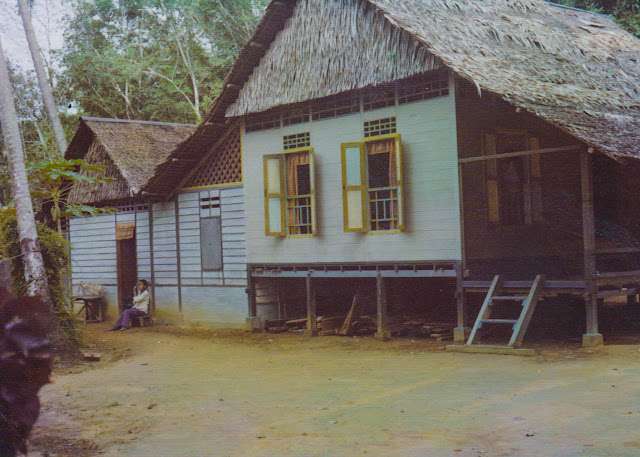The Significance of the Nipah Palm to Ubin's Malay Kampungs
The Nipah Palm (Nypa fruticans), also spelt in English as the nipa palm, is a plant that grows in brackish water and can be found thriving in mangrove forests found commonly in Southeast Asia; Singapore included. These plants appear to be trunkless as its body is mostly submerged in mud. The nipa palms are also mostly found in calm estuaries or shallow lagoons with permanent and high inflows of freshwater, that are not exposed to waves and a high level of water salinity from the sea.
The Nipah palms are believed to be in a vulnerable state, in the Red List of threatened plants of Singapore, and that most of the localities where these population of nipa palms are found are at risk of being wiped off due to national development. To date, the only populations of these mangrove trees that are protected are at places such as Sungei Buloh, Pulau Tekong and Pulau Ubin.
In the eastern part of Pulau Ubin, the Nipah palms can be significantly found in two accessible areas - the first being in Chek Jawa Wetlands, and the other at the end of Jalan Durian. To those who might have been following WUJ thoroughly, the location of the latter is also known locally as Sungei Awang Minyak; the northeastern tributary of Sungei Durian.
 |
| An aerial view of the Nipah palms cluster seen in Chek Jawa taken from the Jejawi Tower |
|
|
Situated along the borders of Kampung Sungei Durian and Kampung Surau, the clusters of Nipah palm along Sungei Awang Minyak played a significant role for the Malay residents of these two villages. One of its more particular uses were in its fronds.
NIPAH FRONDS USED AS ATTAP ROOFS
 |
| My grandparents' house, 818K, when it still had an attap roof; circa the early 1980s. |
Prior to the zinc roofs that are a common sight on the kampung houses that you can find on Pulau Ubin today, villagers in the past would have had attap roofs made from the dried Nipah palm fronds. My mom recalls helping her parents preparing the attap roof for her house:
"Your grandfather would bring out his cleaver and strip off the leaves of the Nipah palm by the stream [Sungei Awang Minyak]. He would pick out the slightly mature ones - not too young neither the ones that have already wilted.He would then bend the leaves in two over a length of nipa stalk placed horizontally and laid out across the open ground. After which, your grandmother and I would sew the leaves together using rattan [twine] which she harvested from within the Ubin forests. The leaves would then be left out to dry in the sun, before they are placed on the battens of the roof as roof shingles.As and when the leaves have worn out and rainwater was able to seep through the attap roof, that is when your grandfather would have to replace the damaged shingle with a new one. Usually, we might prepare some spare ones earlier and place them under the kolong (void deck under the raised house). [Consider it saving up for a literal rainy day]."
The attap roofs on kampung houses were later gradually replaced with zinc roofing because it was more feasible and required little care and maintenance. My grandparents' house also made the switch sometime in the mid-1980s.
 |
| My grandparents' house after the roof was replaced with zinc, circa the mid-1980s. Photo courtesy of Hj Musa Sulong (Awang Minyak) |
Apart from roofing purposes, the Nipah palm also plays a part in our delicacies, too.
THE NIPAH FRUIT AS A LOCAL DELICACY
 |
| The nipa fruit as seen from the Chek Jawa Mangrove Boardwalk |
The Nipah fruit is of a nice chestnut brown colour and grows in a cluster, forming a globular shape which averages in about 20-25 cm in diameter. The kampung folks would love to harvest them while they are still attached on the tree because that is when the seeds are still immature; in its endosperm state. When one plucks out the individual seeds, they are able to retrieve the jellylike sweetmeat known as "attap-chee" - which is found in the majority of our local desserts such as our ice kachangs!
I also learned that our palm sugar, or more locally known as "Gula Melaka", comes from the Nipah tree, too! It is retrieved through boiling the collected sugar-rich saps until it thickens. The boiled sap could then be sold as a syrup in bottles or more commonly found, solidified as cakes and bricks. The palm sugar is also a key ingredient in many of our traditional Malay kuehs, such as the ondeh-ondeh and kuih lopis etc.
|
|
In conclusion, the Nipah palms were an integral part of the Ubin kampung community because of its multiple purposes and benefits to the people here. This also once again highlights the role in which nature is a source of sustenance to the people of Pulau Ubin in how it provides for them; and also, how the people provide back to nature, through proper agriculture and care. Nature and people are inseparable, highlighting the importance of a moderate and balanced co-existence.
Sources and Reference:
- Attap nipah. (2020, October 31). The Malay History and Culture. https://malay--history.blogspot.com/2020/10/attap-nipah.html
- @linleo82. (n.d.). Added by @linleo82 Instagram post Pertama kali melihat merasa buah nipah.. #throwback #blkkampong #perak #kgsuami #kampungstyle #weekend - Picuki.com. Picuki. https://www.picuki.com/media/1580892272751665478
- Tan, R. (2010, August 23). Attap roofs back in fashion. Wild Shores of Singapore. https://wildshores.blogspot.com/2010/08/attap-roofs-back-in-fashion.html#.X-5gONgzaUk
- Tan, R. (2013, January). Nipah palm (Nypa fruticans) on the Shores of Singapore. Wildsingapore. http://www.wildsingapore.com/wildfacts/plants/mangrove/nypa/nypa.htm
- What are Attap Seeds?|Palm Seeds. (2019, September 27). Lion Brand Rice: Jasmine Rice Australia. http://www.lionbrand.com.au/blog/what-are-attap-seedspalm-seeds
════ ⋆★⋆ ════
Follow WUJ on social media!
Facebook
Instagram
Twitter
Have any enquiries? Send an email to wansubinjournal@gmail.com
════ ⋆★⋆ ════








Comments
Post a Comment